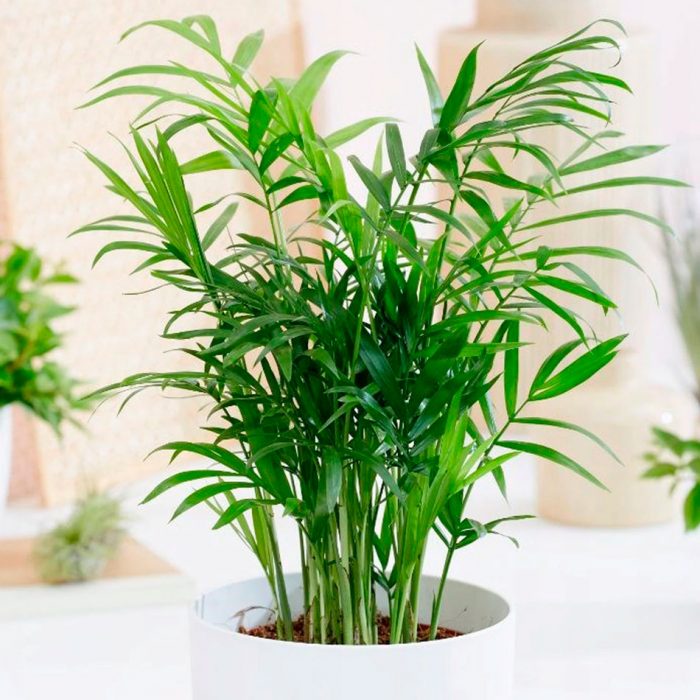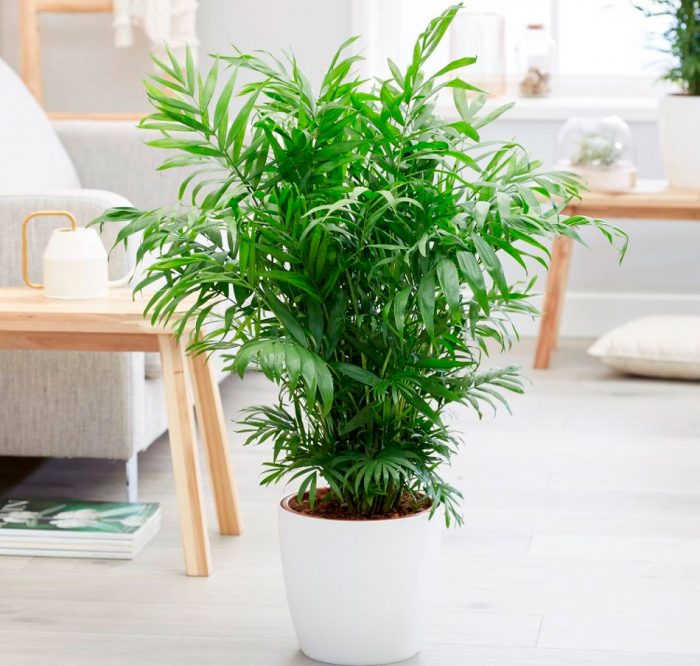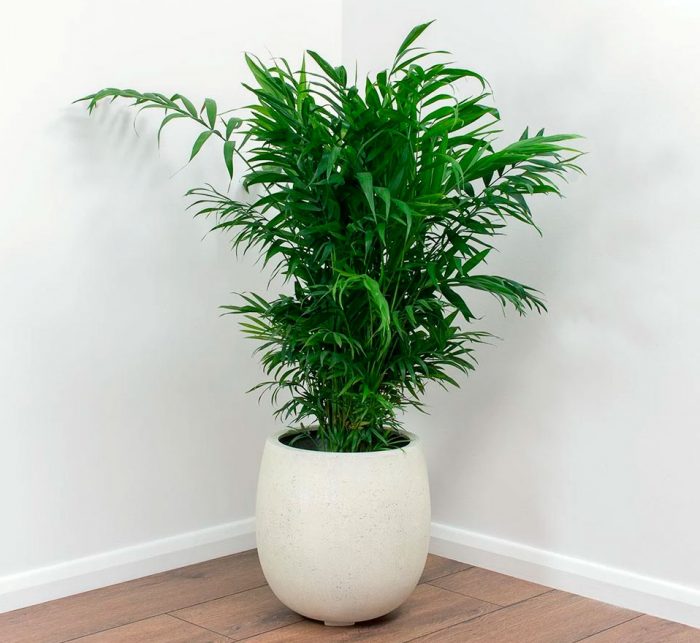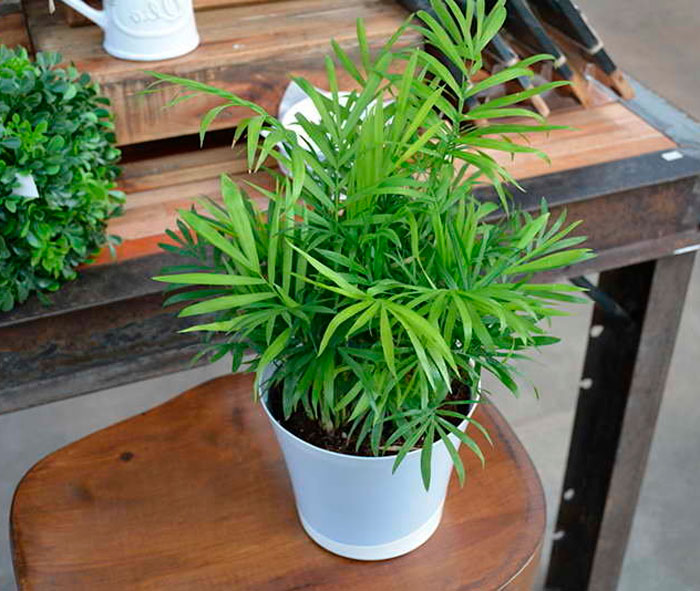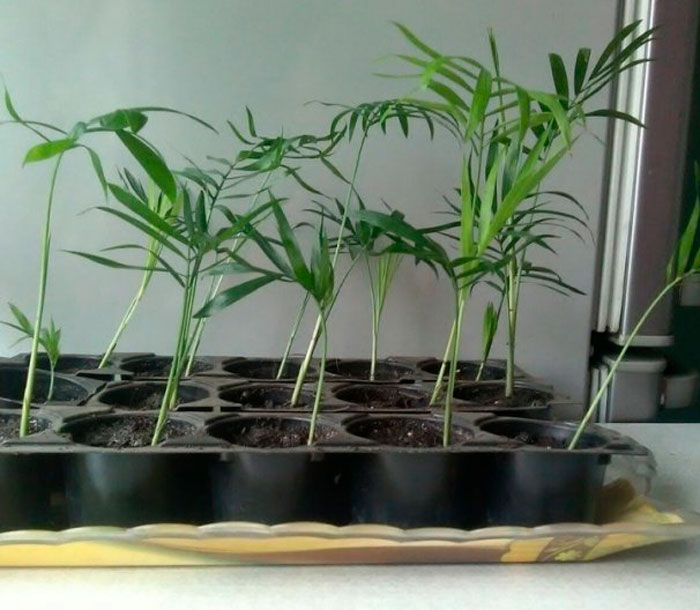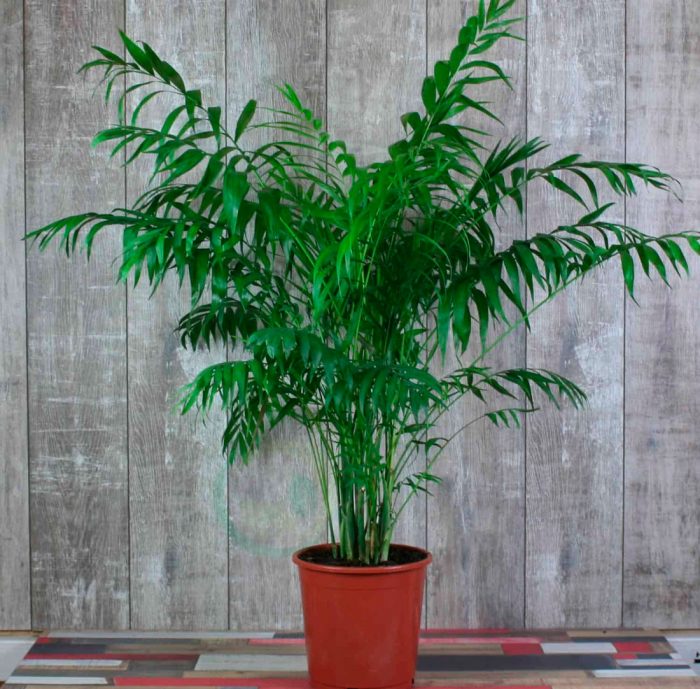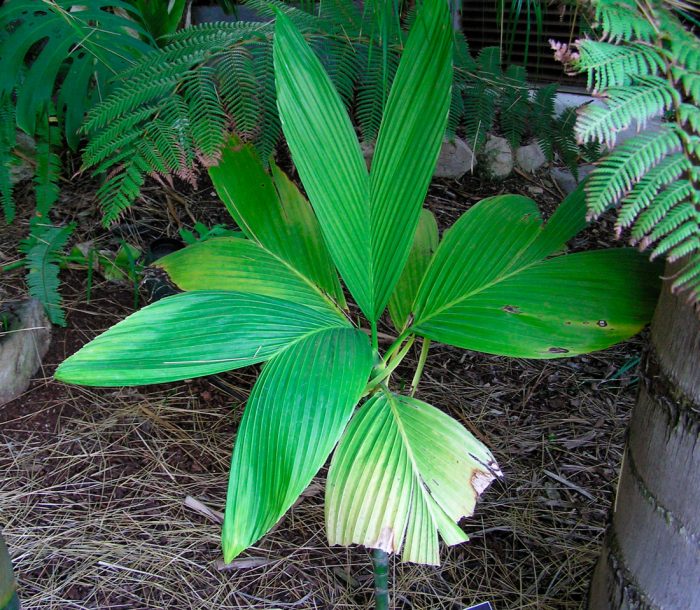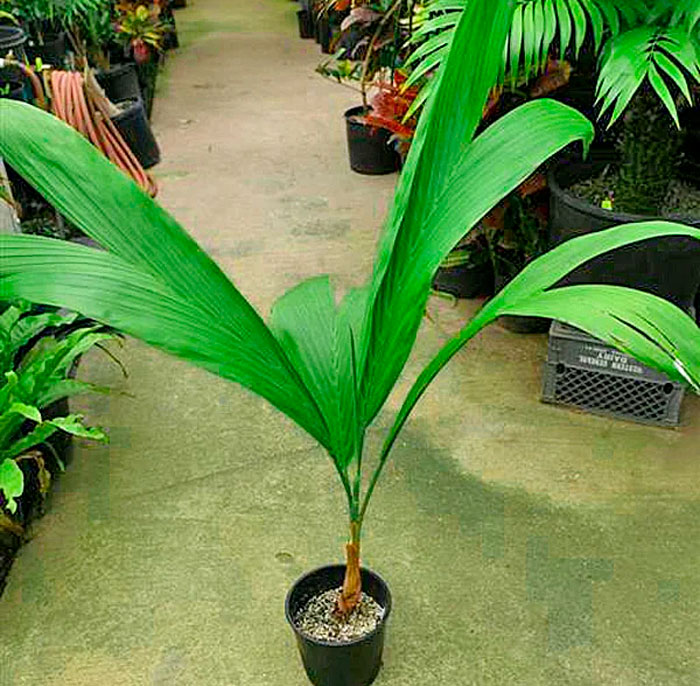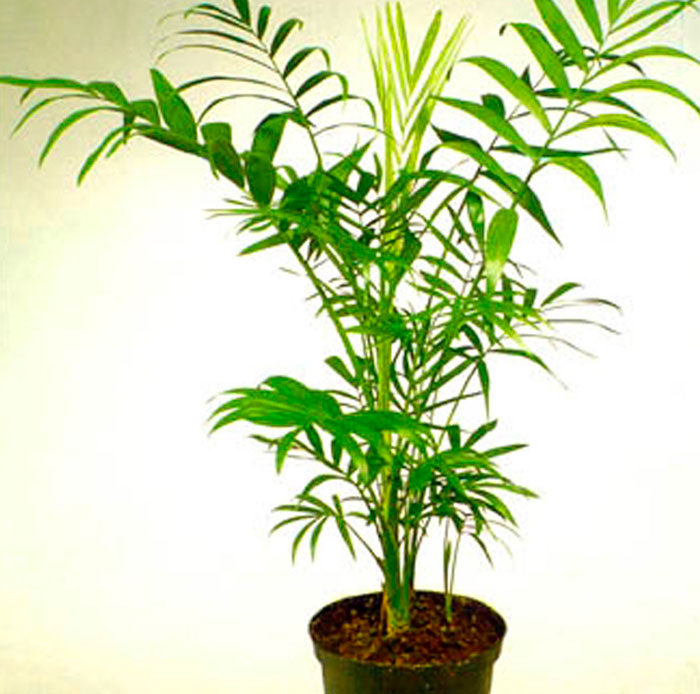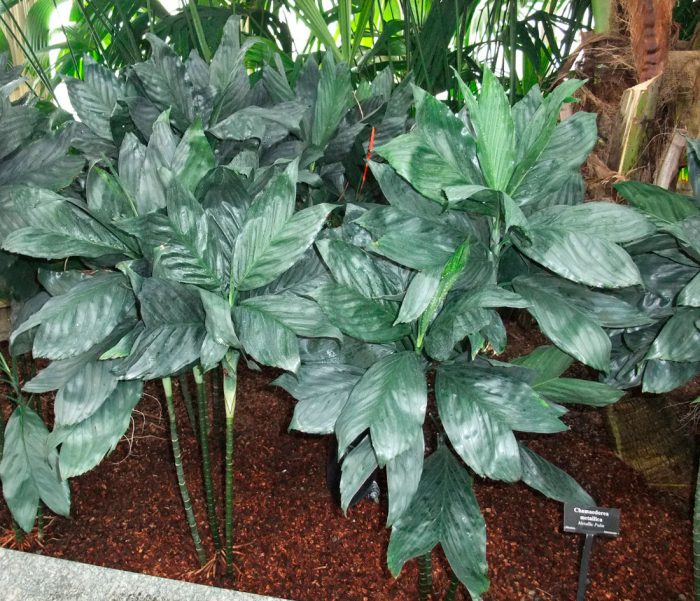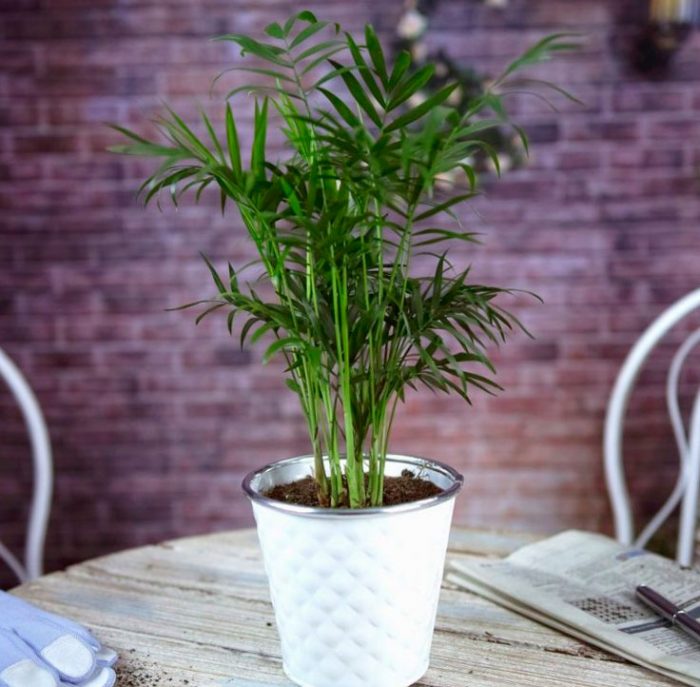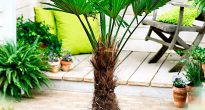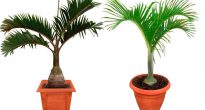The chamedorea palm (Chamaedorea) is quite common in indoor conditions. This perennial is a member of the Palm family. This genus includes about 130 different species. This plant is native to tropical Central America, East Africa and Madagascar. Some of the species can be found in the nature of the Caucasus, Crimea and southern Europe.
The most common shrub forms of this plant. However, there are also liana-shaped chamedoreas, and bushes with one stem. This palm tree grows very slowly. Within 12 months, 1 or 2 new leaf plates are formed.
Among the hamedorei, there are female and male bushes. They differ from each other in flowers: in women, they are saturated red or orange, single, and in men, yellow and red, they are part of the inflorescences.
This perennial plant is very easy to grow indoors. Moreover, it forms flowers only in natural conditions.
Content
Brief description of cultivation
- Temperature... The optimum air temperature is from 12 to 20 degrees. Reacts negatively to excessively high and low temperatures.
- Air humidity... The optimum humidity level is about 50 percent. But it feels fine even at a lower humidity level.
- Illumination... In the summer, the potting soil should be slightly damp all the time. In winter, the frequency and abundance of watering are reduced.
- Watering... The soil mixture is moistened immediately after the top layer of the substrate dries up systematically and abundantly.
- Substrate... In order to do it yourself, combine peat, sand, deciduous and sod soil (1: 1: 1: 3).
- Fertilizer... Top dressing is carried out regularly 1 time in 15-30 days. To do this, use a universal complex mineral fertilizer, and the dosage should be 2 times less than indicated by the manufacturer.
- Transfer... A young bush is transplanted once a year, and an adult - once every 3 years.
- Reproduction... By dividing the bush, offspring and seeds.
- Care features... It needs to be watered frequently and needs protection from direct sunlight.
Home care for chamedorea
Bloom
Indoor chamedorea can bloom from the third year of growth. In order to enjoy the flowering of such a palm tree all year round, several bushes should be planted in the pot at once. Lovely fragrant yellow flowers look like mimosa.
While the bush is young, it is recommended to cut out all the flower stalks, since it spends a lot of energy on flowering, which will negatively affect its growth and development. To "revive" the palm, it is recommended to apply fertilizer to the substrate.
Temperature
Reacts extremely negatively to excessively high air temperature in the room. In this regard, on hot summer days, be sure to ventilate the room. In winter, the bush should be kept cool (from 12 to 18 degrees), and at this time it should be protected from hypothermia and drafts. This palm tree is distinguished by its vitality, and therefore it can survive even in a critical situation.
Air humidity
Chamedorea feels best at a humidity level of about 50 percent. To maintain such humidity, it is recommended to regularly moisten the bush from a spray bottle with well-settled water once a day. If the humidity in the room is not too low, then it is enough to moisten the plant 2-3 times, and in winter - once a week. If the palm is not moistened regularly, it will not wilt, but this can lead to the appearance of spider mites.
To keep the leaves clean and tidy, the plant can sometimes be given a warm shower. An overly large bush is sprayed with plenty of water instead.
Illumination
The palm tree feels quite normal in shade, but the best place for it is an oriental window sill. Hamedorea can be used to decorate a room with poor lighting. If the light is too bright, it will lead to yellowing of the foliage, while the bush will begin to wither.
Watering
In the warm season, watering should be abundant, while making sure that the substrate in the pot never dries out. This plant is a moisture-loving plant, and therefore should be watered quite often: 2 or 3 times a week. However, make sure that the liquid does not stagnate in the substrate, as this can negatively affect the health of the palm tree.
In winter, the plant is watered no more than 1 time per week. This sparse watering will help prevent rot on the root system.
Pot selection
There are different opinions about choosing a pot for hamedorea. There is an opinion that it must necessarily be close. Some growers believe that it should be very large. If you do not know what opinion to hold, then choose a pot a few centimeters wider than the diameter of the root system.
Soil mixture
To prepare the soil mixture, it is necessary to combine the high-density sod soil with peat, sand and leafy soil. The acidity of the soil mixture can vary from 5 to 6.5. If you decide to use a purchased soil mixture, then "Palma" is suitable for you. But it should be mixed with a little sand.
Top dressing
In the warm season, feeding is carried out 1-2 times a month, for this they use a universal mineral complex fertilizer, for example Agricola. However, you need to use ½ part of the dosage recommended by the manufacturer. In the winter months, fertilizer is not applied to the soil mixture.
Hamedorea transplant
While a young bush is transplanted annually, each time the container is replaced with a larger one. Remember that adult hamedorrhea reacts negatively to a transplant. Therefore, adult specimens are transplanted only when the root system becomes very cramped. To understand this, pay attention to the drainage holes at the bottom of the pot, the roots should stick out of them. On average, an adult bush is transplanted once every 4–5 years. In other years, it is recommended to simply replace the top layer of the substrate with a new one.
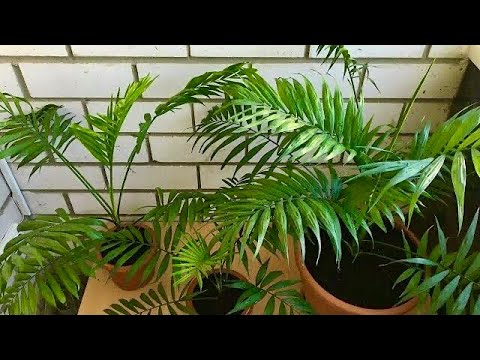

Watch this video on YouTube
Pruning
It happens that large brown spots form on the foliage, they must be removed. All yellow dried leaf plates are also cut out, and they are cut off, capturing a little living tissue.
The leaves are cut off with very sharp scissors, and they must be disinfected with alcohol. The processing of the cut sites is carried out with a solution of a fungicidal preparation. Some gardeners advise that it is imperative to cut flower stalks in young bushes, thanks to this, the growth and development of the palm tree in the future will improve.
Dormant period
During the dormant period, which is observed in winter, the plant must be properly looked after. It is not fed during this period, rarely watered, and still provide cool content. Humidify foliage from a spray bottle in winter infrequently.
Reproduction methods
Growing from seeds
Hamedorea can be grown indoors from seeds. However, fresh seed should be used for this. The fact is that every month it loses its germination by 10 percent. For seedlings to appear, seeds must be harvested no more than 10 months ago. If you are growing a male and female chamedorea bush, then pollination of flowers can be done manually, and after a while you will have your seeds.
Before sowing seeds, fill them with water for 5 or 6 days. Before soaking, it is necessary to scarify the seed: using an emery paper or a nail file, file the solid seed coat on one side. For sowing, use individual small cups filled with a mixture of sand and peat. The seed is placed in a glass with the filed side down.
It is not necessary to cover the seeds with the substrate. For crops, you will need to build a mini-greenhouse, since they need warmth and high humidity. They are provided with systematic ventilation and watering. If the seeds are collected by hand, the seedlings will appear after 60 days, and from the purchased ones - after 6-8 months. After the leaf plate reaches 40 mm in height, the plant should be transplanted into a larger container.


Watch this video on YouTube
Dividing the bush
An adult, well-grown bush should be carefully pulled out of the pot, after which the clod of earth is removed with a stream of water. Divide the palm tree into several parts, while each division should have strong roots and a fully formed shoot.
Each piece is planted in an individual pot. It will take them about 30 days to adapt. After that, they will start to grow.
Possible problems
Various problems can arise with room chamedorea, for example:
- The tips of the sheet plates dry out... This means that the room has low air humidity. It is necessary to systematically ventilate the room, as well as moisten the bush in time from a spray bottle.
- Yellow foliage... Hard water or too bright lighting is used for irrigation. Move the shrub into shade, and you will also need soft water.
- The appearance of rot on foliage, wilting and dying off... This is most often observed in winter due to the appearance of rot on the root system. This can happen due to stagnation of liquid in the substrate. If the damage is not severe, then water the palm less often and with less water, and do not forget to loosen the surface of the substrate. You can transplant the bush by cutting off the affected roots. A drainage layer is poured at the bottom of the pot, the substrate is made looser and moisture-retaining components are added, for example, charcoal or sphagnum moss.
- Brown specks appeared on the foliage... This happens if the plant is watered with too much water or if it is very hard. Cut off diseased foliage and adjust watering, the water should be soft.
- The foliage turns dark and withers... This is due to hypothermia of hamedorea. Provide the bush with the right growth conditions.
- Fly around the bottom sheet plates... This is a natural process. Old leaves die off. The dried leaves are cut off and the cutting sites are processed.
- A cotton-like bloom appeared on the foliage... This is due to the appearance of the mealybug. The palm tree is sprayed with an insecticidal preparation.
- Pests... In addition to mealybugs, scabies and spider mites can also settle on hamedorea.
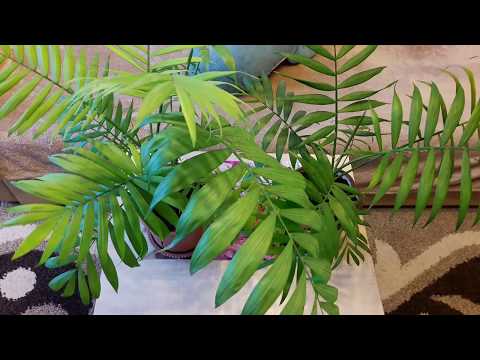

Watch this video on YouTube
Types of hamedorea with photos and names
There are many types of hamedorea, below will be described those of them that are very popular with flower growers.
Hamedorea graceful (Chamaedorea elegans)
Such a single-stemmed perennial reaches a height of 150-200 cm. 6 or 7 feathery leaf plates grow on a smooth trunk. Each leaf blade is divided into narrow-lanceolate segments of a dark green color, there can be from 8 to 15. Paniculate inflorescences are loose and formed from cobs consisting of red-orange flowers. When the bush fades, small black berries form.
Chamaedorea Ernesti-Augusti
This plant has dark green foliage not segmented. It is very wide and large, while sometimes at the top the plate is divided into 2 parts. The species is slow growing. Its shape is stem: only one stem is formed from one rhizome. Sprawling inflorescences consist of red spherical flowers.
Hamedorea high (Chamaedorea Elatior)
Erect long stems are similar in appearance to bamboo. When the lower leaf blade dies off, a light-colored ring can be seen on the surface of the stem. In the upper part of the stem there are from 4 to 6 pinnately dissected leaf plates of a dark green color. The foliage lobes are narrow-lanceolate with a pointed edge. Paniculate inflorescences consist of deep orange flowers.
Hamedorea monochromatic (lat.Chamaedorea Concolor)
The view is the most unpretentious. The stems are slow in growth and reach about 100 cm in length. The species has a bushy shape, since it grows several thin stems. In the upper part of the stem, the pinnately dissected foliage is painted in a greenish tint. The bushes bloom while still young, and panicles consisting of yellow flowers are formed on them.
Hamedorea metal (lat.Chamaedorea Metallica)
The peculiarity of this species is the dark green foliage with a metallic sheen. The leaf plates are wide and not dissected. After some time, the trunk becomes thick and woody. This shade-loving palm tree has a height of about two meters (in indoor conditions, it is lower).
Beneficial features
The chamedorea palm is considered a very useful houseplant, as it is phytoncidoactive. More precisely, the palm tree is able to absorb harmful substances from the air, making it cleaner. She is able to absorb harmful fumes (for example, ammonia, benzene, formaldehyde), as well as other volatile substances.
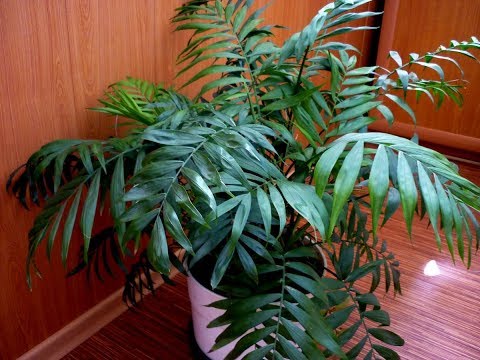

Watch this video on YouTube

